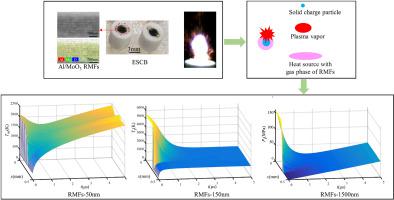当前位置:
X-MOL 学术
›
Def. Technol.
›
论文详情
Our official English website, www.x-mol.net, welcomes your
feedback! (Note: you will need to create a separate account there.)
Identifying the enhancement mechanism of Al/MoO3 reactive multilayered films on the ignition ability of semiconductor bridge using a one-dimensional gas-solid two-phase flow model
Defence Technology ( IF 5.0 ) Pub Date : 2023-08-23 , DOI: 10.1016/j.dt.2023.08.010
Jianbing Xu , Yuxuan Zhou , Yun Shen , Yueting Wang , Yinghua Ye , Ruiqi Shen
Defence Technology ( IF 5.0 ) Pub Date : 2023-08-23 , DOI: 10.1016/j.dt.2023.08.010
Jianbing Xu , Yuxuan Zhou , Yun Shen , Yueting Wang , Yinghua Ye , Ruiqi Shen

|
Energetic Semiconductor bridge (ESCB) based on reactive multilayered films (RMFs) has a promising application in the miniature and intelligence of initiator and pyrotechnics device. Understanding the ignition enhancement mechanism of RMFs on semiconductor bridge (SCB) during the ignition process is crucial for the engineering and practical application of advanced initiator and pyrotechnics devices. In this study, a one-dimensional (1D) gas-solid two-phase flow ignition model was established to study the ignition process of ESCB to charge particles based on the reactivity of Al/MoO RMFs. In order to fully consider the coupled exothermic between the RMFs and the SCB plasma during the ignition process, the heat release of chemical reaction in RMFs was used as an internal heat source in this model. It is found that the exothermal reaction in RMFs improved the ignition performance of SCB. In the process of plasma rapid condensation with heat release, the product of RMFs enhanced the heat transfer process between the gas phase and the solid charge particle, which accelerated the expansion of hot plasma, and heated the solid charge particle as well as gas phase region with low temperature. In addition, it made up for pressure loss in the gas phase. During the plasma dissipation process, the exothermal chemical reaction in RMFs acted as the main heating source to heat the charge particle, making the surface temperature of the charge particle, gas pressure, and gas temperature rise continuously. This result may yield significant advantages in providing a universal ignition model for miniaturized ignition devices.
中文翻译:

利用一维气固两相流模型确定 Al/MoO3 反应多层膜对半导体桥点火能力的增强机制
基于反应多层膜(RMF)的含能半导体桥(ESCB)在起爆器和烟火装置的微型化、智能化方面具有广阔的应用前景。了解半导体桥(SCB)上RMF在点火过程中的点火增强机制对于先进引发剂和烟火装置的工程和实际应用至关重要。本研究基于Al/MoO RMF的反应性,建立了一维(1D)气固两相流点火模型,研究ESCB带电粒子的点火过程。为了充分考虑点火过程中RMF和SCB等离子体之间的耦合放热,该模型采用RMF化学反应的放热作为内部热源。结果发现,RMF 中的放热反应提高了 SCB 的点火性能。在等离子体快速凝结放热的过程中,RMF的产物增强了气相与固体带电粒子之间的传热过程,加速了热等离子体的膨胀,加热了固体带电粒子以及气相区域。与低温。此外,它还弥补了气相的压力损失。在等离子体耗散过程中,RMF中的放热化学反应作为主要热源对带电粒子进行加热,使得带电粒子的表面温度、气体压力和气体温度不断升高。该结果可以在为小型化点火装置提供通用点火模型方面产生显着的优势。
更新日期:2023-08-23
中文翻译:

利用一维气固两相流模型确定 Al/MoO3 反应多层膜对半导体桥点火能力的增强机制
基于反应多层膜(RMF)的含能半导体桥(ESCB)在起爆器和烟火装置的微型化、智能化方面具有广阔的应用前景。了解半导体桥(SCB)上RMF在点火过程中的点火增强机制对于先进引发剂和烟火装置的工程和实际应用至关重要。本研究基于Al/MoO RMF的反应性,建立了一维(1D)气固两相流点火模型,研究ESCB带电粒子的点火过程。为了充分考虑点火过程中RMF和SCB等离子体之间的耦合放热,该模型采用RMF化学反应的放热作为内部热源。结果发现,RMF 中的放热反应提高了 SCB 的点火性能。在等离子体快速凝结放热的过程中,RMF的产物增强了气相与固体带电粒子之间的传热过程,加速了热等离子体的膨胀,加热了固体带电粒子以及气相区域。与低温。此外,它还弥补了气相的压力损失。在等离子体耗散过程中,RMF中的放热化学反应作为主要热源对带电粒子进行加热,使得带电粒子的表面温度、气体压力和气体温度不断升高。该结果可以在为小型化点火装置提供通用点火模型方面产生显着的优势。

































 京公网安备 11010802027423号
京公网安备 11010802027423号